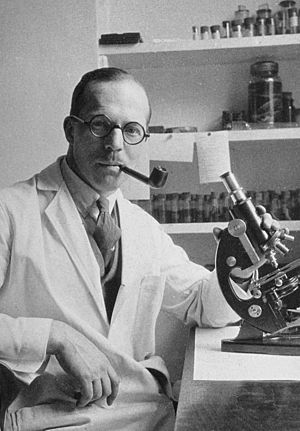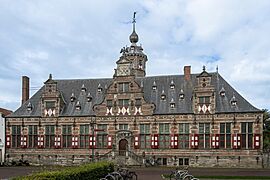Middelburg, Zeeland facts for kids
Quick facts for kids
Middelburg
|
|||||
|---|---|---|---|---|---|
|
City and municipality
|
|||||

Middelburg Stadhuis
|
|||||
|
|||||

Location in Zeeland
|
|||||
| Country | Netherlands | ||||
| Province | Zeeland | ||||
| City Hall | Middelburg City Hall | ||||
| Government | |||||
| • Body | Municipal council | ||||
| Area | |||||
| • Total | 53.04 km2 (20.48 sq mi) | ||||
| • Land | 48.54 km2 (18.74 sq mi) | ||||
| • Water | 4.50 km2 (1.74 sq mi) | ||||
| Elevation | 3 m (10 ft) | ||||
| Population
(May 2014)
|
|||||
| • Total | 47,658 | ||||
| • Density | 982/km2 (2,540/sq mi) | ||||
| Demonym(s) | Middelburger | ||||
| Time zone | UTC+1 (CET) | ||||
| • Summer (DST) | UTC+2 (CEST) | ||||
| Postcode |
4330–4341
|
||||
| Area code | 0118 | ||||
Middelburg is a city and municipality in the south-western Netherlands. It is the capital city of the Zeeland province. Middelburg is located on the central part of Zeeland, which includes the former islands of Walcheren, Noord-Beveland, and Zuid-Beveland. About 48,000 people live there.
Middelburg was important in the Scientific Revolution. It was known for making lenses during the Dutch Golden Age. Many people believe that the microscope and telescope were invented here. Famous spectacle-makers like Zacharias Janssen and Hans Lipperhey worked in Middelburg in the late 1500s and early 1600s.
Contents
History of Middelburg
The city of Middelburg might have started around the late 700s or early 800s. It was first mentioned as one of three strongholds built on Walcheren island. These strongholds helped protect against Viking attacks. In 844, a monastery was built here. It stayed a Catholic center until the Reformation. The main church of Middelburg started being built in the 900s. More parts were added throughout the Middle Ages.
Middelburg received its city rights in 1217. During the Middle Ages, it became a very important trading hub. It connected England with the growing cities in Flanders. Even Geoffrey Chaucer mentioned this in his famous book, The Canterbury Tales. The town grew stronger and more important in the 1200s and 1300s.
From 1559 to 1603, Middelburg was the main church city for a Catholic bishopric that covered all of Zeeland. During the Eighty Years' War, Dutch rebels took the city from Spanish forces. This happened after a long siege from 1572 to 1574. The northern parts of the Low Countries became independent from Spain. They formed the Dutch Republic, which was a Protestant state.
Later, in the 1600s (the Dutch Golden Age), Middelburg became a major center for the Dutch East India Company (VOC). It was second only to Amsterdam in importance. Middelburg was also involved in the trade of enslaved people during the 17th century.
There are two old Jewish burial sites in Middelburg. One is for Sephardic Jews and the other for Ashkenazic Jews. The synagogue was rebuilt in 1994 after being partly destroyed in World War II. It was the third synagogue built in the Netherlands during the Golden Age. At the railway station, there is a plaque remembering the Jews of Zeeland. They started their journey to the death camps from this station during the war.
About one-third of the old city center was destroyed by bombs and fire on May 17, 1940. This happened early in World War II. It is still not clear if German bombers or French artillery caused the damage. British troops freed the town on November 6, 1944, during Operation Infatuate. After the war, much of the destroyed old town was rebuilt. It was made to look like it did before the war. However, the city's old records were burned during the bombing.
Today, Middelburg still has much of its historic and beautiful look. You can see many grand merchant houses and warehouses from the 1600s and 1700s. They stand along the canals, similar to buildings in Amsterdam. The old city moats are still there, along with two old city gates: the Koepoort Gate and the Varkenspoort Gate. The medieval abbey is still used today as a museum and for the provincial government.
Famous People from Middelburg
Middelburg has been home to many interesting people.
Artists and Writers
- Ambrosius Bosschaert the Elder (1573–1621) was a famous painter of still life pictures. He worked in Middelburg for most of his life. His three sons, Johannes Bosschaert, Ambrosius Bosschaert II, and Abraham Bosschaert the Younger, also became painters.
- Pieter Gaal (1769–1819) was a painter who was born, lived, and died in Middelburg. He traveled all over Europe to paint.
- Adrianus Valerius (c. 1575 – 1625) was a Dutch poet and composer.
- Balthasar van der Ast (1593/94 – 1657) was another important Dutch Golden Age painter.
- Ariana Nozeman (1626/1628 – 1661) was the very first actress in the Netherlands.
- Pieter Cornelis Boutens (1870–1943) was a Dutch poet and mystic.
Scientists and Explorers
- Zacharias Janssen (1585 – c. 1632) was a Dutch spectacle-maker. He is often credited with inventing the microscope.
- Jacob Roggeveen (1659–1729) was an admiral and explorer. He was born and died in Middelburg. He discovered Easter Island in the South Pacific Ocean in 1722.
- Petronella Johanna de Timmerman (1723–1786) was a scientist and poet. She became an honorary member of an academy in 1774.
- Isaac Beeckman (1588–1637) was a Dutch philosopher and scientist.
- Lili Bleeker (1897–1985) was a Dutch scientist and business owner. She designed and made optical instruments.
Public Service and Sports
- Sir Balthazar Gerbier (1592–1663) was a diplomat and art advisor.
- Etty Hillesum (1914 – 1943) was a Dutch writer known for her letters and diaries.
- Harald Bergmann (born 1965) is the current Mayor of Middelburg since 2012.
- Jan Poortvliet (born 1955) is a retired football (soccer) player. He played in 531 club games.
- Elisabeth Willeboordse (born 1978) is a judoka. She won a bronze medal at the 2008 Summer Olympics.
Geography and Climate
Besides the main town of Middelburg, the municipality also includes other smaller places. These include Arnemuiden, Kleverskerke, Nieuw- en Sint Joosland, and Sint Laurens.
The town is close to the coast, but far enough inland (10–15 km) that its weather is a bit different. Winters are a little colder, and summers are a little warmer than right on the coast. Middelburg has a mild oceanic climate. This means it has few extreme weather events. Winters are usually mild, and summers are cool. Rain falls fairly evenly throughout the year.
Gallery
Culture and Fun Things to Do
In 1575, William of Orange wanted to start the first university in the Netherlands. He first thought about Middelburg. But he chose Leiden instead. Middelburg did not get a university until 2004. That's when University College Roosevelt opened, which is part of Utrecht University. There is also a campus of the HZ University of Applied Sciences in the city.
Cultural Places
- Zeeuws Museum
- Vleeshal (an art exhibition space)
- Sjakie's Chocolademuseum (Chocolate Museum)
- Zeeuws Archief (Zeeland Archives)
- Zeeuwse Bibliotheek (Zeeland Library)
- Centrum Beeldende Kunst (Visual Arts Center)
- University College Roosevelt
Theaters and Concert Halls
- Schouwburg (Theater)
- Concertzaal Zeeland (Concert Hall)
- Spiegeltheater
- Minitheater
- Filmtheater Schuttershof (Movie Theater)
- UCR Stand up comedy theatre
Places to See
- The Abbey
- Kuiperspoort
- The "Lange Jan" (Long John) tower
- City Hall
- Oostkerk (East Church)
- Damplein (Dam Square)
Sports
Middelburg has a rugby club called Oemoemenoe. It also has four football (soccer) clubs: MZVC, Zeelandia Middelburg, Jong Ambon, and FC Dauwendaele. Jong Ambon means "Young Ambon" and has mostly players from Ambonese backgrounds. FC Dauwendaele is the club for the Dauwendaele neighborhood.
Getting Around
Middelburg has a railway station. You can take intercity trains from here to many cities. These include Vlissingen, Goes, Roosendaal, Rotterdam, The Hague, Leiden, Haarlem, and Amsterdam. Four trains leave every hour in both directions.
Sister Cities
Middelburg is connected with these cities around the world:
 Folkestone, United Kingdom
Folkestone, United Kingdom Głogów, Poland
Głogów, Poland Nagasaki, Japan
Nagasaki, Japan Simeria, Romania
Simeria, Romania Teiuș, Romania
Teiuș, Romania Vilvoorde, Belgium
Vilvoorde, Belgium
See also
 In Spanish: Midelburgo para niños
In Spanish: Midelburgo para niños

























